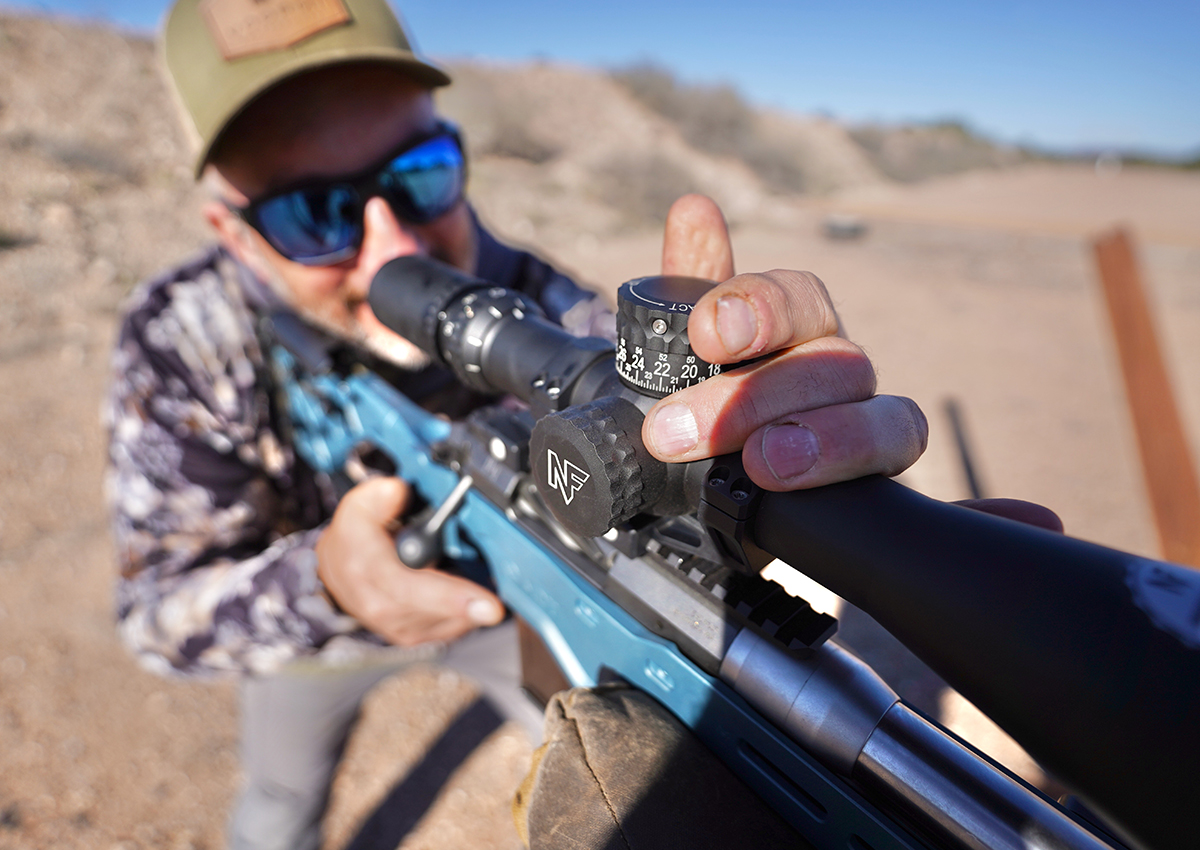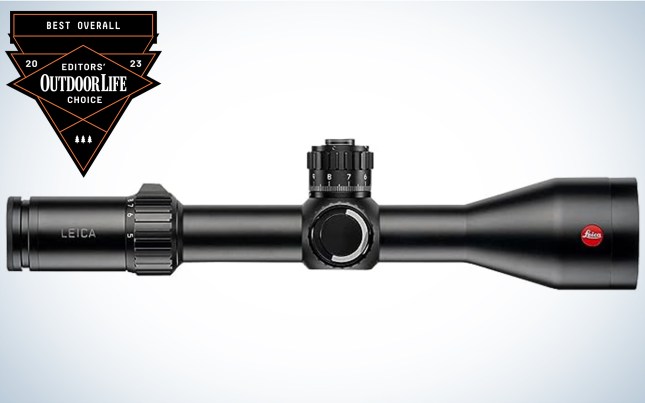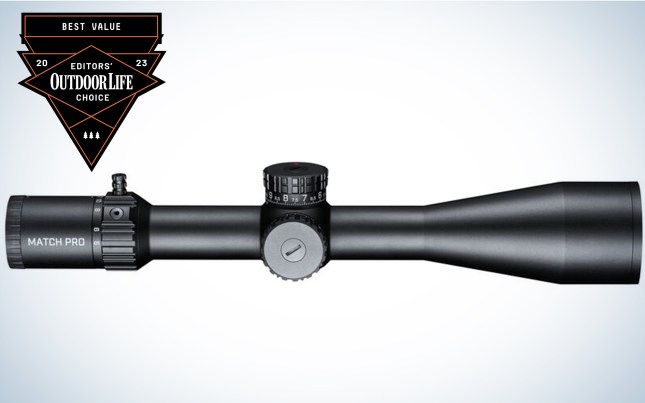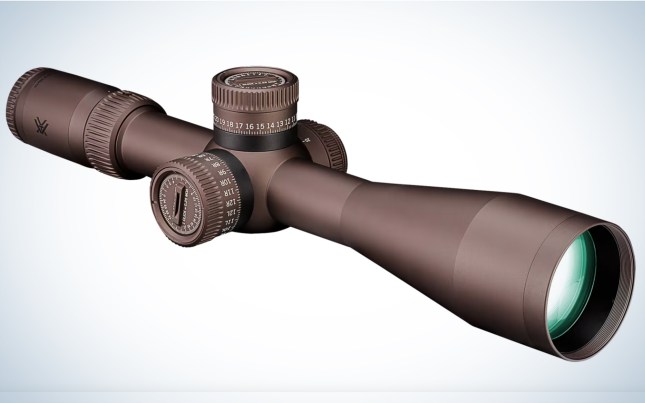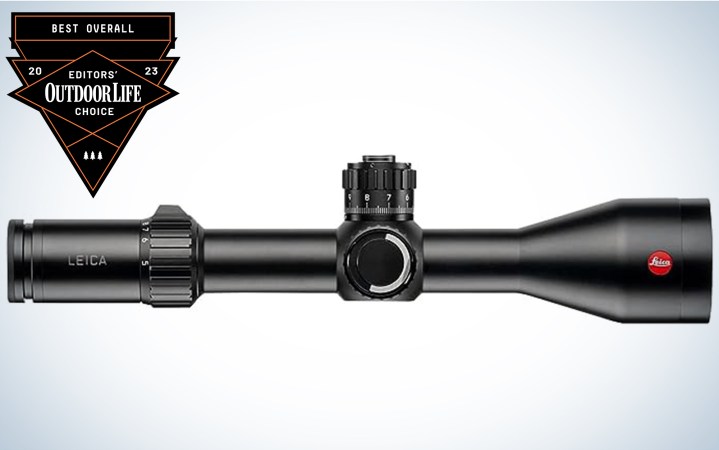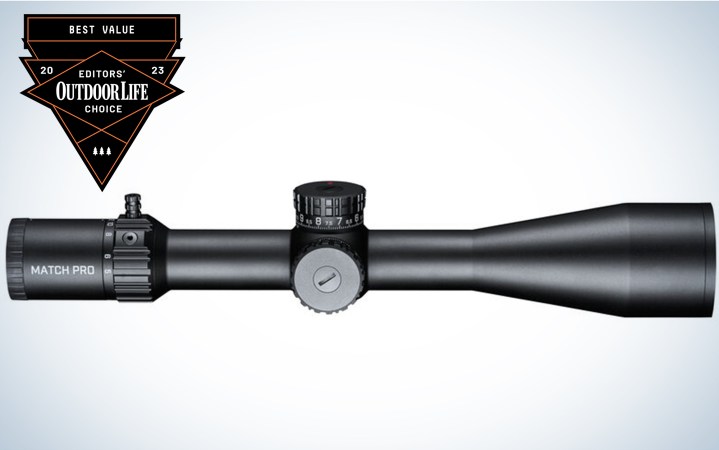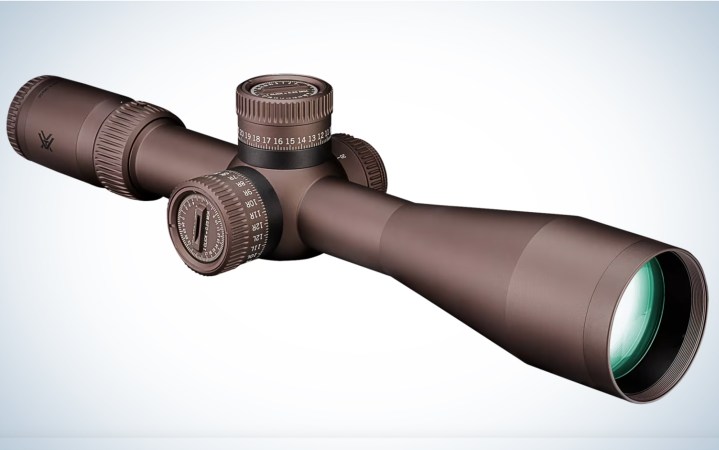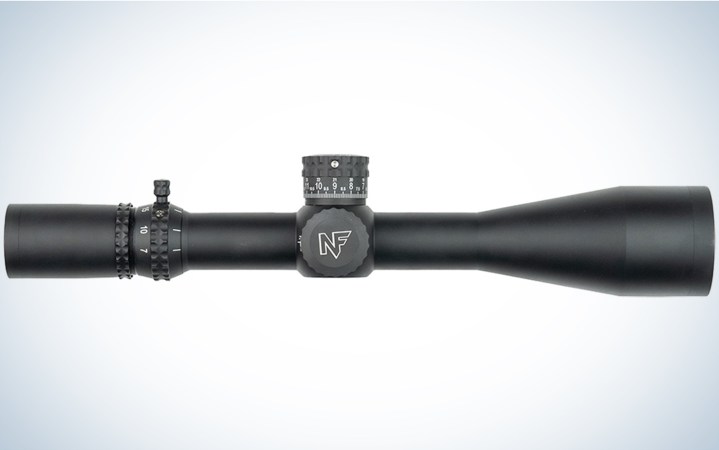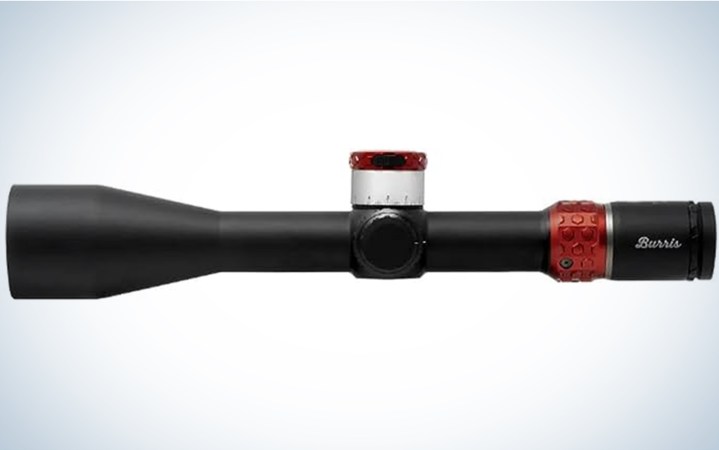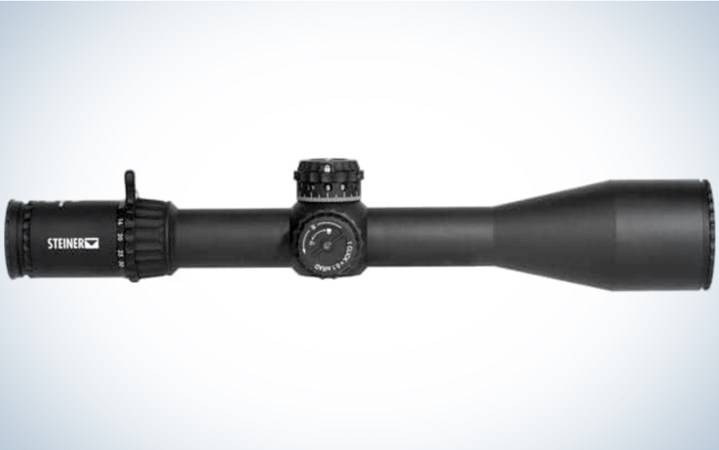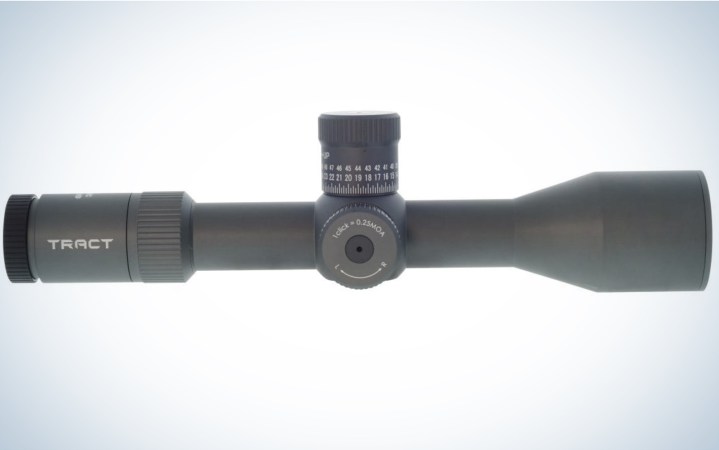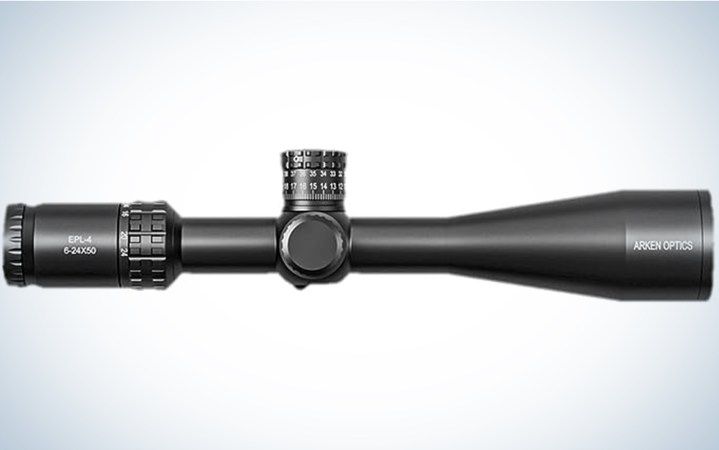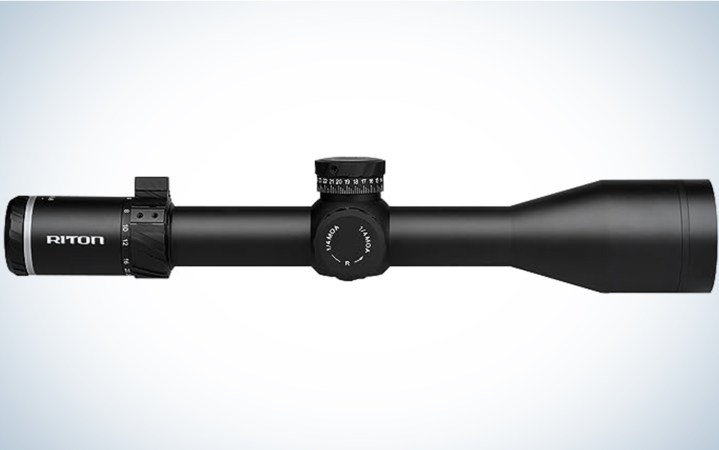We may earn revenue from the products available on this page and participate in affiliate programs. Learn More ›
The value proposition of a long range rifles cope is straightforward, literally. It must place, with absolute repeatability, a small projectile in a very specific spot, often over great distances.
Optical clarity is a valuable bonus, because precision scopes double as glassing instruments, but their main job is bullet delivery. The variables that assist with that job—granular reticles, turrets that turn with positivity and precision, magnification, focus, and illumination controls—are generally more important than low-light brightness and optical perfection. Our test is designed to assess attributes in that order: precision and utility first, optics second.
Given the sophistication and competence of precision scopes that we’ve seen normalized over the last couple years, it’s hard to imagine that just 10 years ago it was hard to find a target scope that had a useful first-plane reticle, reliable controls, and the durability to stand up to the abuse of dynamic precision-rifle competition. Now, we’re seeing competent competition scopes for under $500, and the best of the class are optical instruments that marry world-class glass with precise gearing that must work on a heavy recoiling rifle in the grit, wind, stress, and chaos of competition.
Few hunting scopes can stand up to that level of expectation.
For a few years now, we’ve wanted to test the best precision scopes from our previous tests alongside new introductions. How well do newcomers compare against standards of the class? That was the basis of this year’s best long range rifle scopes test, in which about half the field has been on the market for at least a year, and half are new for 2023. The goal was to help readers find the best long range rifle scope for their shooting requirements, personal preferences, and budget.
- Best Overall: Leica PRS 5-30x56i
- Best Value: Bushnell Match Pro ED
- Best Innovative Riflescope: Vortex Razor HD Gen III 6-36×56
- Best MOA-Based Precision Scope: Nightforce ATACR 7-35×56 F1
- Best Competition Scope: Burris XTR Pro 5.5-30×56
- Steiner T6Xi 5-30×56
- Tract Toric UltraHD 4-25×50
- Best Entry-Level: Arken EPL-4 6-24×50
- Riton 7 Conquer 4-32×56
How We Tested the Best Long Range Rifle Scopes
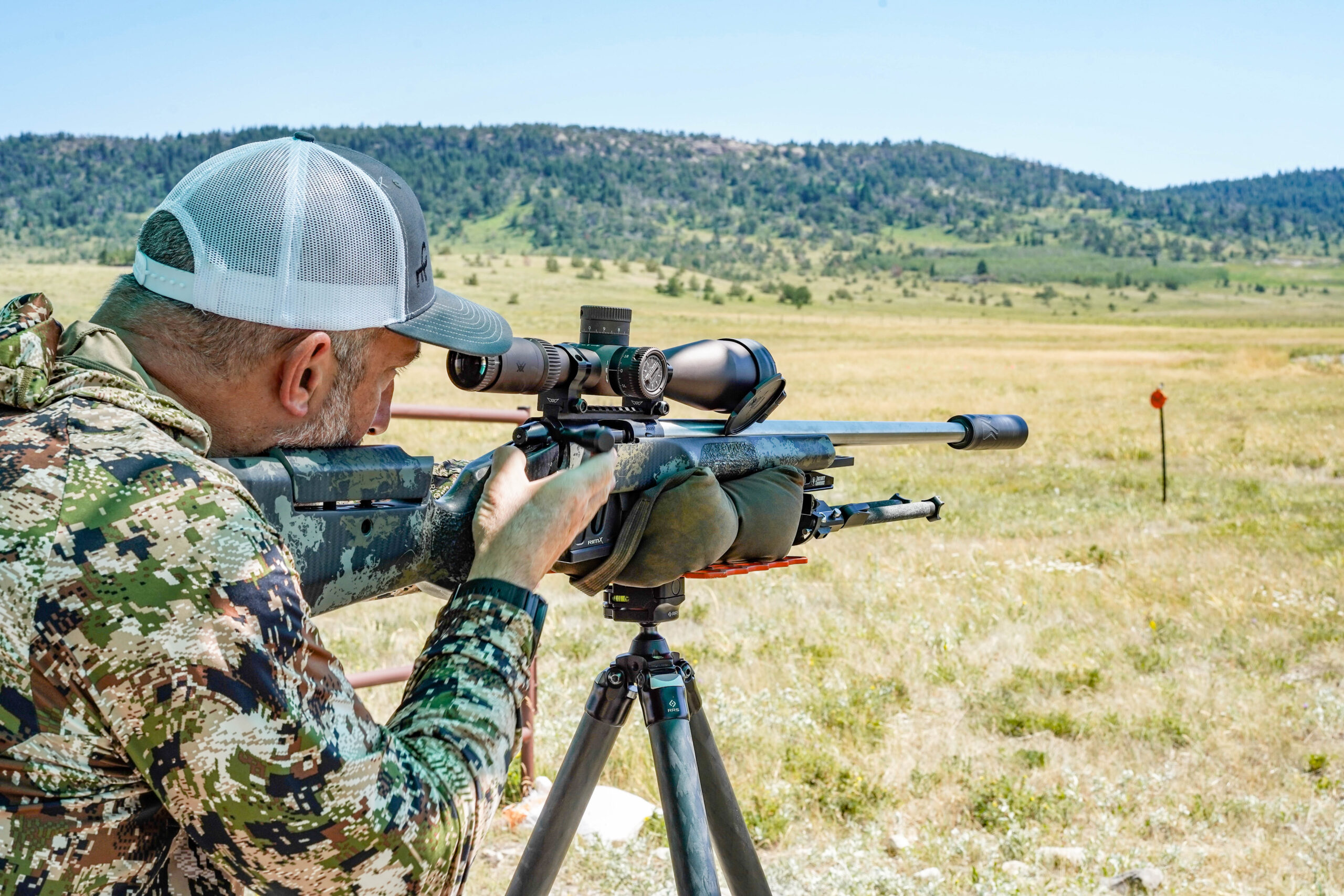
Because riflescopes are essentially aiming devices, we evaluate them differently than binoculars or spotting scopes, optical instruments that have broader utility. We’re interested in the precision of a riflescope, so our scoring criteria gives more weight to attributes that achieve that goal.
Main Test Criteria
We test optical performance, same as we do spotters and binoculars. But we spend more time on four criteria that we think are the beating heart of a solid riflescope. Our “interior aiming system” considerations are reticle style and utility, illumination, reticle references, and visibility. Our “exterior aiming system” evaluation considers turret positivity and indexing, the scope’s zero stop, parallax control, and total internal adjustment range, meaning how far shooters can stretch the turrets’ elevation and windage clicks. We also test a range of attributes that we bundle under the heading “precision,” which include turret tracking, return to zero, the trueness of the scope’s magnification, parallax, and field of view. And then we ask testers to rate a scope’s “shootability,” which considers eye relief, the ease of use at various magnifications, and the scope’s versatility.
That last consideration—versatility—is one of the more interesting evolutions in the galaxy of long range rifle scopes. Used to be, a precision scope was calibrated for .308 Win., or maybe .223 or .338 Lapua Magnum, all early long-range target platforms, or even converted military sniper scopes. But with the rise of the precision 6mms, and even more significantly, the popularity of .22 rimfire matches, precision scopes must be capable of placing a wide variety of bullet weights, designs, and ballistic characteristics at ranges from 20 to 2,000 yards.
Standard Bearers
We shot a couple of scopes we consider Platonic ideals of the platform, including Zeiss’s excellent LRP S5 and the Nightforce ATACR with Mil-XT reticle. The purpose of having these two standard-bearers on the range was as a basis of comparison. How well do Burris’s turrets turn compared with the Zeiss? How does the Riton reticle compare with the Mil-XT, which is arguably the winningest reticle on the Precision Rifle Series circuit?
Optical Resolution
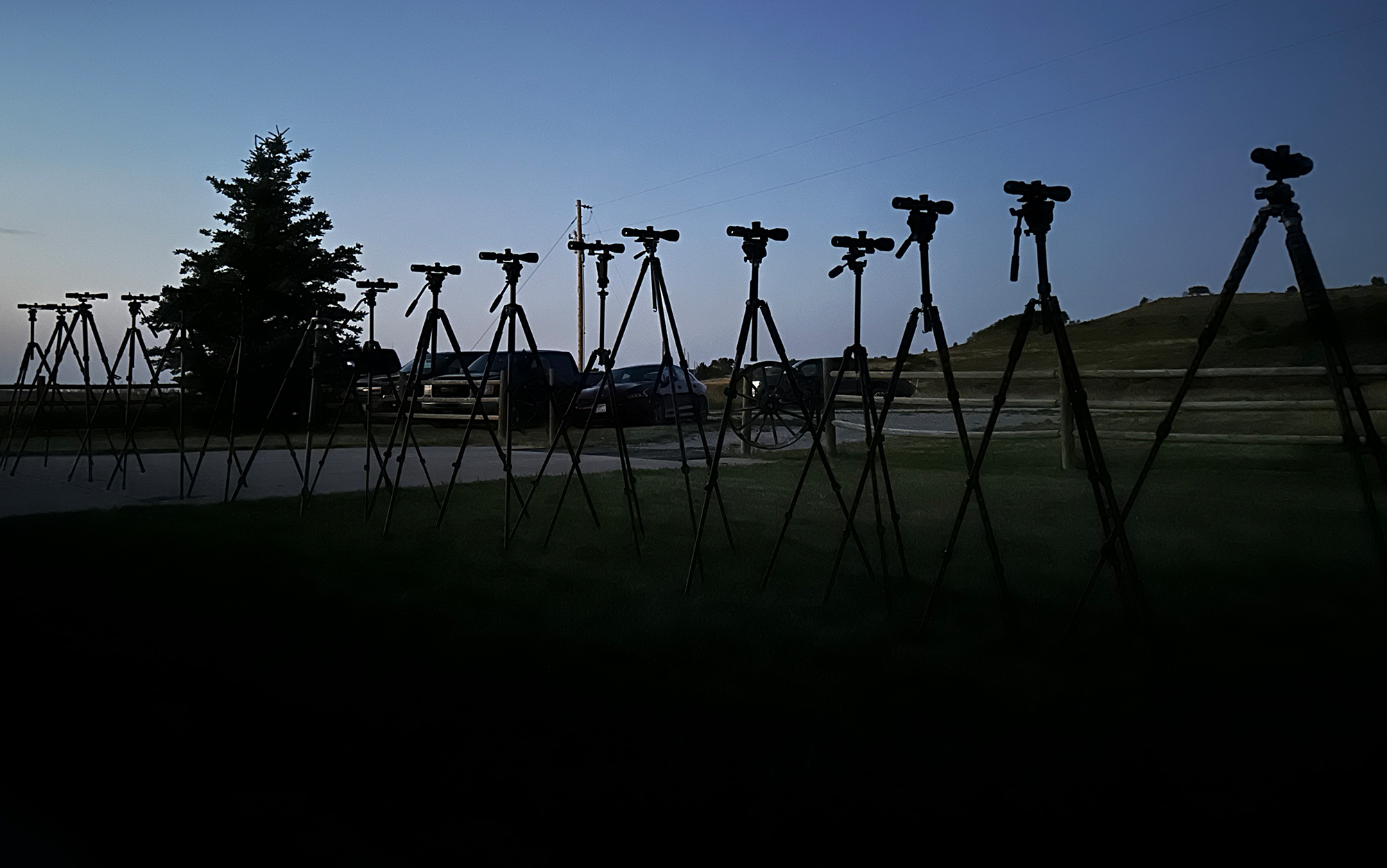
But back to our testing protocol. We put all submissions through the same criteria. First, we measure optical resolution using the diminishing black-and-white lines of a 1951 Air Force Resolution Target to score the optical performance of each submission. We also measure the low-light performance of each long range rifle scope by mounting them to tripods and focusing them as a group at 200 yards at a black-and-white resolution target at twilight, all in order to measure the brightness of the glass. As we discussed, neither resolution nor low-light performance are deal-breakers for this category, but both criteria provide valuable insights into the optical performance of the scope.
How We Score and Grade Long Range Rifle Scopes
We break our 10-point scoring into four general categories:
- Optical performance (25 percent of total grade)
- Aiming system (50 percent of total grade)
- Design (15 percent)
- Value (10 percent)
The average of these categories is the basis of our grades, detailed below.
Optical performance includes the resolution and low-light tests plus the more subjective assessments of image quality and brightness. Aiming-system performance assesses interior and exterior aiming system, precision, and shootability. Design considers the exterior finish, interior blacking, mounting dimensions, and durability.
And then our price/value score rates how much scope—along with warranty and amenities such as rings, extra turrets, and lens covers—you get for your money. The best long range rifle scope with the highest overall score wins our Editor’s Choice award; the optic with the highest price/value score wins our Great Buy recognition, and we give other awards based on specific attributes.
How We Grade Long Range Rifle Scopes
Our 100-point evaluation adds up to a total numeric score, but we translate those to grades for each submission. The Optical Performance grade combines the scores from resolution, low-light, and image quality. Our Aiming System Performance grade aggregates the interior/exterior aiming system, precision, and shootability scores. The Design grade considers Construction, Innovation, Versatility, and Durability. And then the Price/Value grade is our value grade.
To earn an “Excellent” grade, the average of that category must be 9 or higher, which is extremely hard to achieve. “Very Good” is an average score of 7 to 9. A “Good” grade is 5 to 7. Our “Fair” grade is 3 to 5, and “Poor” is anything under 3.
Best Long Range Rifle Scopes
Best Overall: Leica PRS 5-30x56i
Score Card
- Optical Performance: Very Good
- Aiming System: Excellent
- Design: Excellent
- Price/Value: Good
Key Features
- 5-30-power magnification
- 34mm tube
- 32 MRAD elevation, 18 MRAD windage adjustment
- First-plane MIL-based PRS illuminated reticle
- Tool-less turret removal
- Zero-stop tools stow under turret cap
- 22 yards to infinity parallax correction
Pros
- Extremely bright and clear glass
- Velvety controls
- PRS reticle is simple and versatile
- At 14 inches, fairly compact
- Elegant proportions and design
Cons
- Reticle offered only in MIL, not MOA
- Less internal adjustment than peers
- At about $2,900, spendy price
The performance of the Leica PRS scope, when stacked up against some excellent newcomers, frankly surprised the test team. We’ve been admirers of the European precision scope since Leica introduced the PRS in 2020, but we didn’t expect it to stand up to competition from Vortex, Steiner, Nightforce, or Zeiss, brands that have all brought new and very capable precision scopes to market in the three years since Leica unveiled its PRS.
We’re happy to report that the Leica not only thwarted its dethroners, but it did it with both style and elegant precision.
The Leica precision scope is defined, like so many of its other optics, by beautiful, luxuriant design and responsive mechanics. “Everything on this scope speaks to its quality,” noted tester John B. Snow, OL’s shooting editor. “Tight, smooth controls. Great tactile feedback. Lovely fine aiming points on the reticle.”
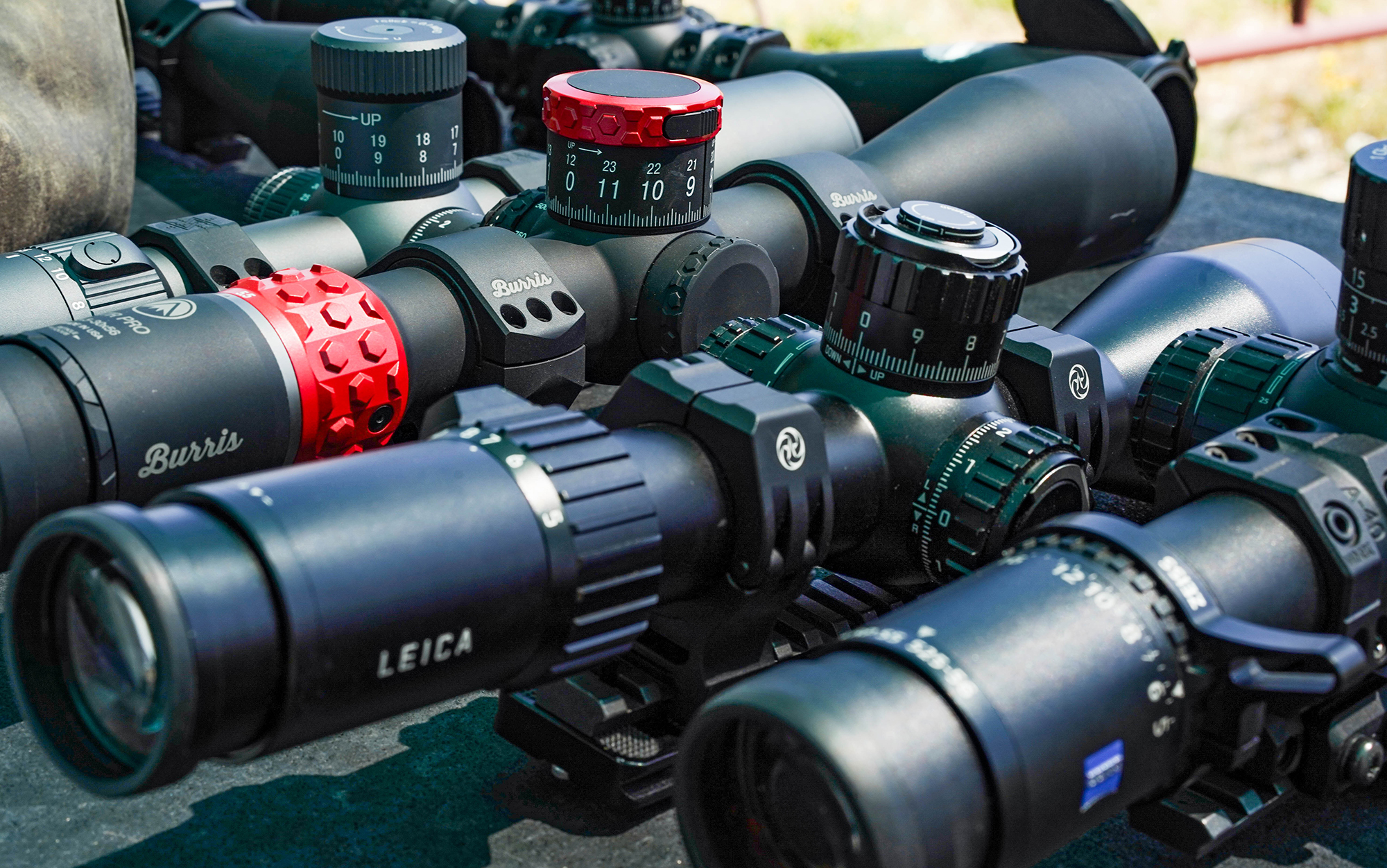
The enduring success of the Leica PRS speaks to the quality of its components. The world-class glass is crisp and clear, which amplifies the reticle detail. The turrets are positive and tight, evidence of precise machining. And the design is timeless, which might be expected of a global company that has to appeal to European hunters and American competitive shooters.
But design and luminous glass don’t win long-range shooting competitions. Absolute precision and agreement between turret and reticle do, and Leica’s mechanical performance has allowed it to stand the test of time. Controls turn with tight, smooth precision, and the tactile feedback from its turrets is the best in the class. The PRS reticle is built around an open .1 MIL dot with .2 MIL steps in a Horus-style grid. It’s a fast, simple, versatile reticle that isn’t intended to be flashy or innovative but rather quietly precise. It must be noted that the windage dots are too faint for some shooters using the scope under 10-power magnification, and the reticle could use weighted visual references for even faster deployment.
The tool-less elevation turret is a thing of mechanical beauty and simplicity, and the compact design is a nice change from a trend toward gargantuan precision scopes. The mounting dimensions on the 34mm tube are a little stingy, but we haven’t found an action or receiver rail it doesn’t fit.
The Leica’s elegant lines and royal bearing might deceive some shooters that it’s simply easy on the eyes. But the PRS is among the most precise and responsive optics we’ve ever tested.
Best Value: Bushnell Match Pro ED
Score Card
- Optical Performance: Good
- Aiming System: Very Good
- Design: Fair
- Price/Value: Excellent
Key Features
- Pull-to-turn turrets
- ED glass in objective lens
- Turret revolution indicator
- 34mm tube
- First-plane DM2 reticle
- 11-step illumination
- 15 yards to infinity parallax adjustment
- 30 MRAD elevation, 14.5 MRAD windage adjustment
Pros
- At around $650, excellent price
- Ships with throw lever and sunshade
- Turrets are easy to rezero
- Clear and useful turret indexing
- Simple and durable zero stop
Cons
- Turret clicks are mushier than peers
- Image is dark
This is one hell of a scope for the money. Actually, it’s a hell of a scope for twice the price. Bushnell’s reinvented Match Pro brings a very useful and versatile reticle for just about any type of target competition, very good controls, and honest performance. Our test is designed to find shortcomings in just about any submission, but try as we might to detect where Bushnell cut corners to arrive at an under-$700 precision scope, we couldn’t find fatal flaws.
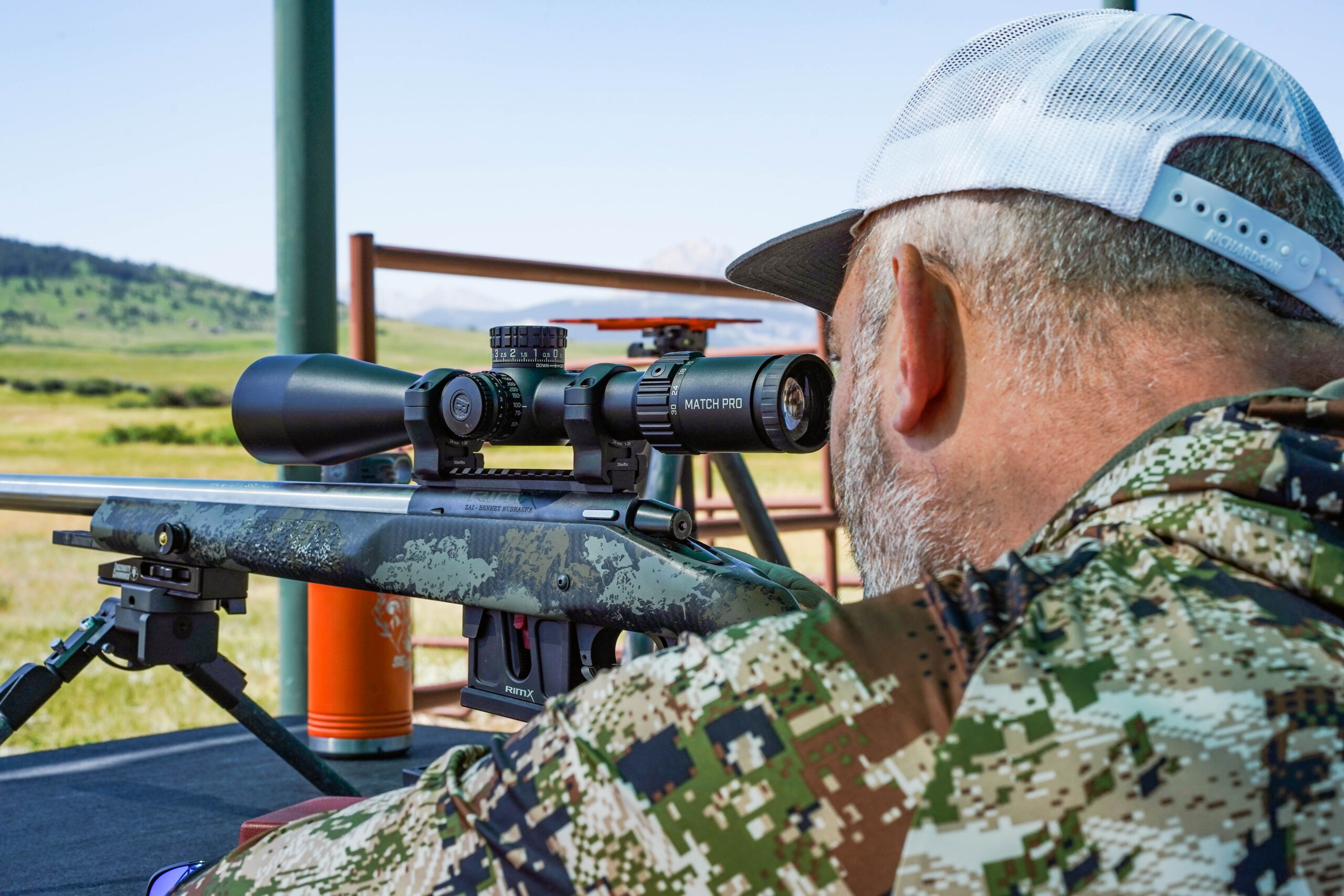
That’s not to say this scope is on par with the $3,000 submissions in the field. The optics are forgettable, despite extra-low-dispersion glass in the objective lens. And turret components are similarly pedestrian; we noted some mushy response in our dialing regimen.
But here’s what you get for your money, and why we tapped the Match Pro ED as our Great Buy in the precision riflescope field. You get low-profile, beautifully indexed turrets with a smart red button that pops up on the second revolution, a very serviceable reticle, and a range of adjustment that can win rimfire competitions and should show up on PRS and NRL long-range steel competitions over the next few years.
“I’d recommend this scope for any shooter on a budget,” said one tester, who amended his comment. “Actually, I’d recommend this scope for a shooter on any budget.”
The DM2 reticle, which stands for Deploy Mil 2, was one of the most visible precision reticles in our low-light test, which measures how long shooters can see a non-illuminated reticle in the dark in order to make a reasonably certain shot. Its weight is balanced between visibility and non-obscuring of the target, and it makes good use of nomenclature, with even-numbered holds in a large font and odd-numbered holds in a smaller font. In all, it’s a fast, serviceable reticle.
Add Bushnell’s excellent warranty to the mix, and you get a very useful precision scope for a fair price, and should be considered by any shooter looking to get into long-range and rimfire competitions.
Best Innovative Riflescope: Vortex Razor HD Gen III 6-36×56
Score Card
- Optical Performance: Very Good
- Aiming System: Very Good
- Design: Very Good
- Price/Value: Fair
Key Features
- Micro-adjust turret dial
- L-Tec+ Zero Stop
- 34mm tube
- First-plane EBR-7D reticle available in MRAD or MOA
- Lockable illumination dial
- 10 yards to infinity parallax correction
- External turret rotation indicator
- 36.1 MRAD elevation, 15.5 MRAD windage adjustment
Pros
- Innovative zeroing system
- Excellent glass
- Infinite zero setting positions between clicks
- Clear and precise indexing
- Simple, fast, and precise reticle references
- Ships with throw lever, lens caps, sunshade, tools
Cons
- Reticle markings could be bolder
- Locking turrets are hard to activate
- At about $4,000, one of the most expensive precision scopes
Vortex might have been satisfied with simply upgrading the reticle inside its flagship precision scope, which has won enough PRS and NRL matches to qualify as a class leader. But with the new Gen III version of the venerable Razor HD, Vortex has created a new turret system that is precise, smart, and innovative.
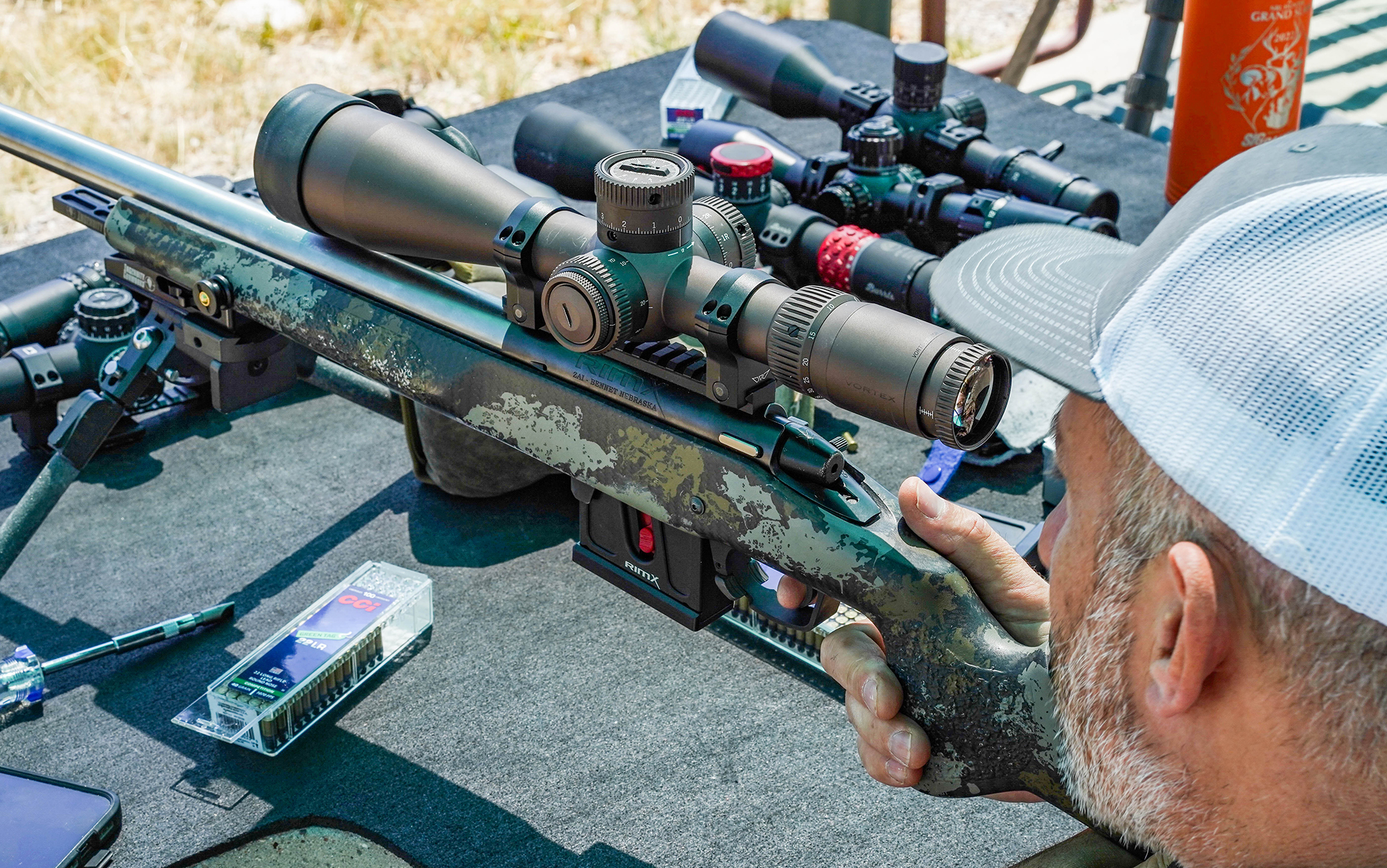
The heart of the turret update is what Vortex calls its L-TEC+ zero system in which relaxing a single set screw allows users to make fast and precise turret adjustments. The system allows zeros to be established between the turrets’ .1 MRAD clicks, meaning that shooters no longer have to be satisfied with turrets set a half click above or below their true zero, a fudge factor that is more problematic the farther you shoot.
The operation takes a bit of getting used to. Tester John B. Snow, thinking the external slot on the head of the turret was designed to accept a beefy screwdriver bit, reefed on our sample, breaking the pot-metal, before reading the instructions and learning that once the retaining screw is loosened, the turret moves easily with only fingertip tension. Our other rifle-range revelation: The creepy caterpillar-looking grub that emerges from the base of the turret is not an embedded chrysalis but rather a smart revolution indicator that becomes fully emergent on the third full rotation of the elevation turret.

For the smart turret updates, the Vortex wins our Innovation Award, but that’s hardly the only update to this excellent scope. The new EBR-7D reticle is a marvel of efficient simplicity. Built around a .03 MRAD red-illuminated center dot with open aiming cross, the reticle’s elevation steps are in .2 MRAD hatches, and windage steps in .2 MRAD dots. We would like to see slightly bolder indexing, as the reticle references were hard to see below about 11-power.
The image delivered by the Razor HD is one of the best in the class, and we liked the turret indexing and smart and useful pull-to-turn illumination control. With a very close parallax adjustment and the infinitely adjustable zero, this would make an excellent rimfire competition scope.
Vortex is understandably proud of this scope, but with a retail price of around $4,000, we think it’s pretty pricey compared with its peer group.
Best MOA-Based Precision Scope: Nightforce ATACR 7-35×56 F1
Score Card
- Optical Performance: Very Good
- Aiming System: Excellent
- Design: Very Good
- Price/Value: Fair
Key Features
- New MOA-based competition reticle
- Original ZeroStop elevation turret
- Push-button Digillum illumination
- 34mm tube
- 100 MOA (29 MRAD) elevation, 60 MOA (17 MRAD) windage adjustment
- 11 yards to infinity parallax adjustment
- Exposed elevation, capped windage turrets
Pros
- Excellent class of glass
- Remarkably responsive turrets
- Liberal mounting dimensions
- Ships with premium lens covers, throw lever
Cons
- Locking quick-focus eyepiece is dated
- At over $3,500, it’s a pricey scope

We’ve been testing Nightforce ATACRs since 2016, when the company brought out the 4-16×50 version of what was to become the OG of the best long range rifle scopes. We’ve seen the magnification and capabilities of the flagship Nightforce grow in proportion to the requirements of its customers, and the appearance of the ATACR atop PRS champions’ rifles for the last decade is a testament to its capabilities.
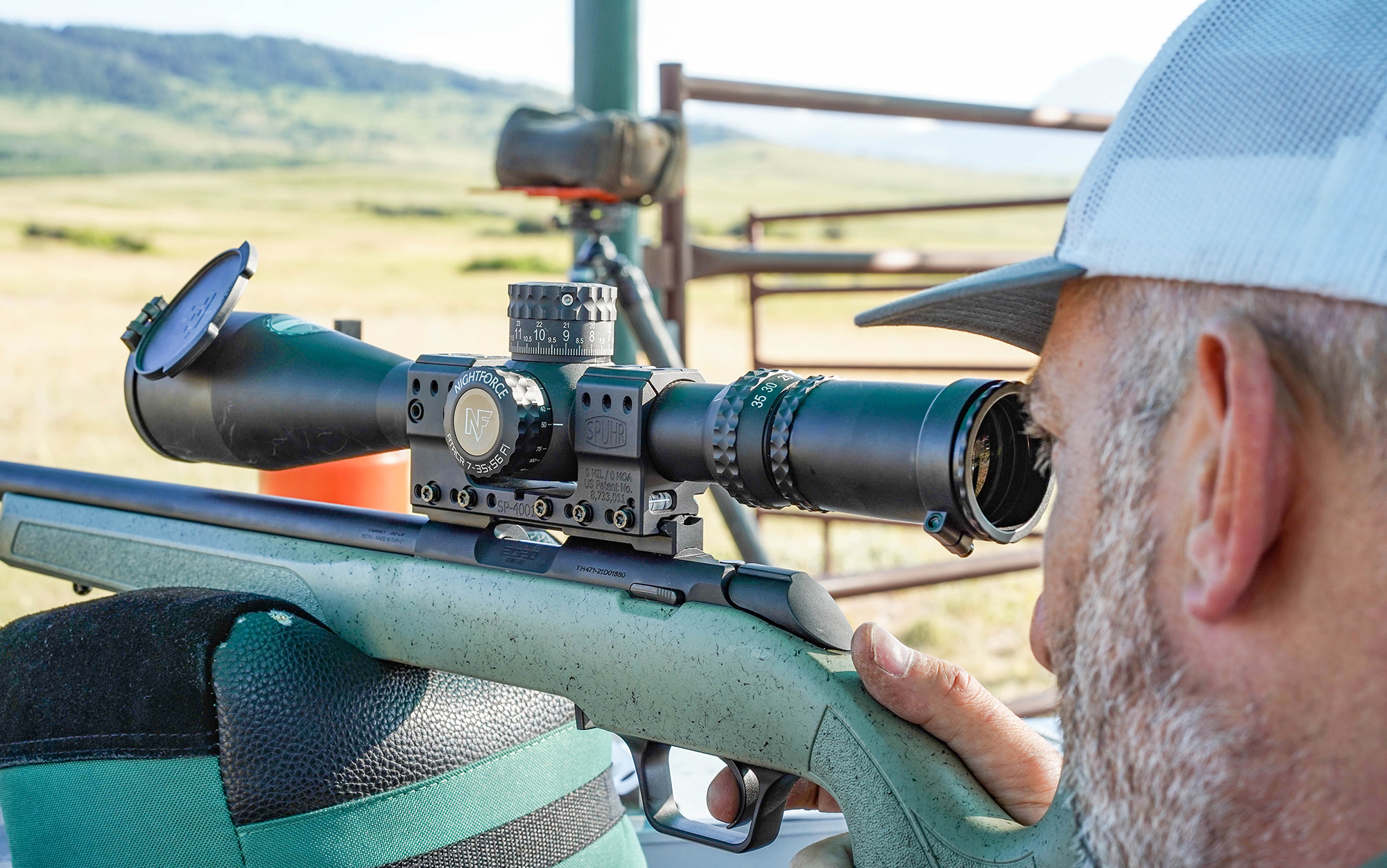
But Nightforce hasn’t been satisfied owning the MRAD market. With an MOA version of the ATACR, it hopes to win over shooters who have stubbornly resisted the transition to mils. The heart of the new Nightforce is what it calls its MOA-XT reticle, an MOA-based Horus-style grid reticle that provides fast and clear aiming points.
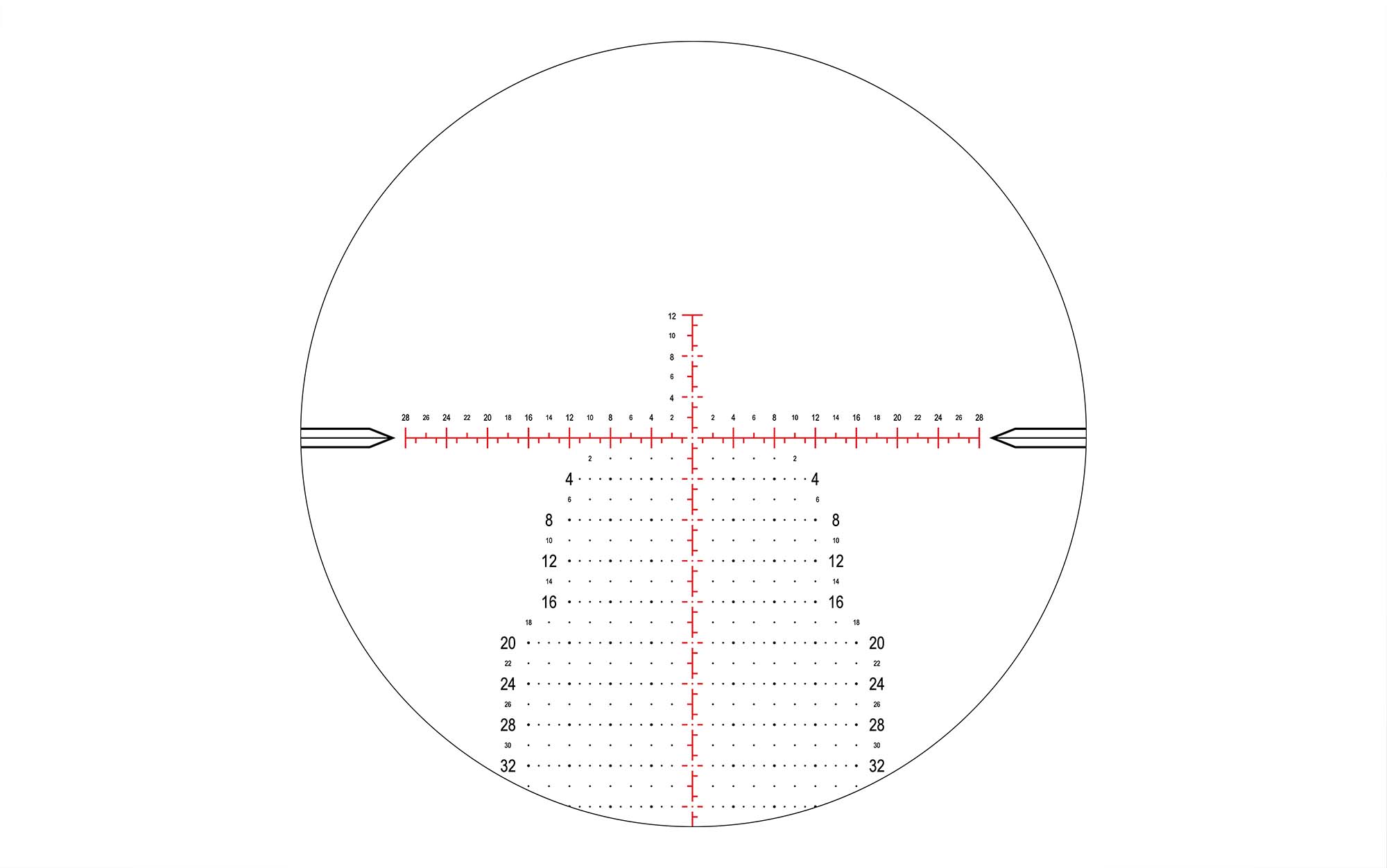
“The reticle is about as good as an MOA-based reticle can be for dynamic long-range shooting,” said one tester, a confirmed MIL shooter. Indeed, at first glance, the MOA-XT appears to be based on MRAD values, but a closer look shows the granularity that MOA-based reticles are known for, with a .16 MOA central aiming point and 1 MOA marks on the main stadia with numeric labels every 2 MOA and bold dots every 4 MOA on the horizontal stadia.
Beyond the new reticle, the ATACR brings everything you’d expect to the platform: excellent glass with best-in-class edge clarity, very responsive turrets tuned to .25 MOA click values, and a smart push-to-activate illumination system. Mounting dimensions on the 34mm tube are excellent, and the platform’s durability has been proven in competitions and on battlefields for a decade.
Best Competition Scope: Burris XTR Pro 5.5-30×56
Score Card
- Optical Performance: Good
- Aiming System: Very Good
- Design: Good
- Price/Value: Fair
Key Features
- Tool-less Zero Click Stop elevation knob
- Ships with extra Quick Detach Race Dial
- Choice of three MIL-based reticles
- 34mm tube
- High-profile elevation, capped windage turrets
- Red and green illumination
- 20 yard to infinity parallax adjustment
- 26 MIL elevation, 15 MIL windage adjustment
Pros
- Distinctive style
- Wide field of view
- Tool-less zeroing is smart and fast
- Useful choice of reticles
- Ships with throw lever, sunshade, extra turret dial
- Race dial features “whiteboard” coating for customized tunes
Cons
- Gritty controls
- Some edge distortion
- At about $2,500, pricey scope
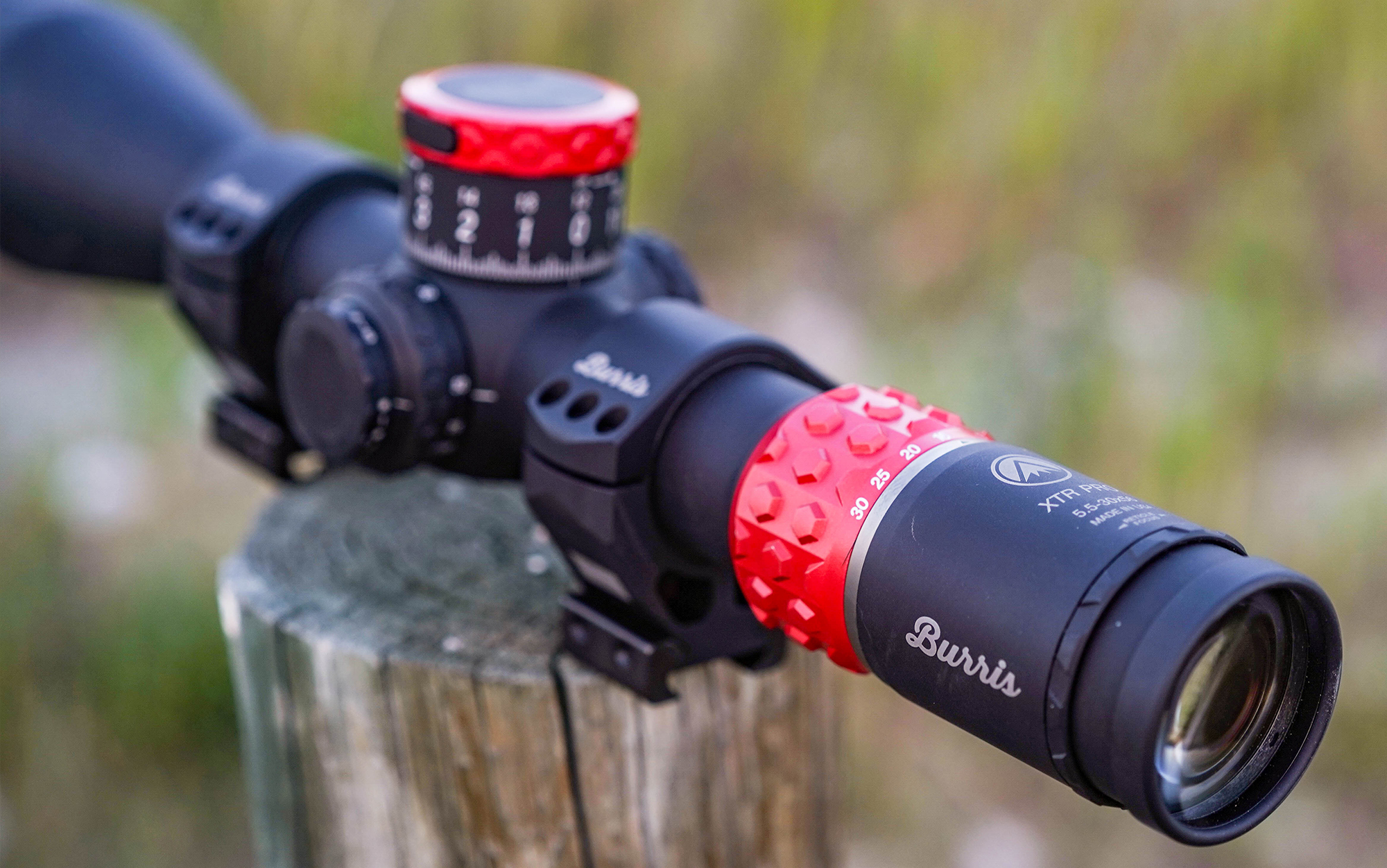
Our test team returned with mixed feedback on this scope. Half love the race-car style that helps the XTR PRO stand out in a field of same-looking black tubes; the other half felt the styling was a thinly veiled attempt to differentiate Burris from Steiner, owned by the same holding company. Half our testers thought the customized “Race Dial” is a genius device to quickly dial between known distances at various shooting stations in competition. Other members felt like this was an unnecessary shortcut.
More unanimous was the high praise for the optics. The Burris finished near the top of the field in both resolution and low-light performance, and shooters generally liked the image, though some detected edge distortion at lower powers. On the mechanical side of the ledger, testers reported that the turrets, parallax, and illumination knobs all had noticeable grit or tightness in their movements.
The XTR PRO is available in three different reticles, all first-plane MIL-based models. There’s the SCR2 ¼ MIL reticle and the venerable Horus TREMOR5. Our test sample came with the excellent SCR2 MIL reticle, which is relatively sparse but has enough references to be functional not only at long-range steel targets but also on rimfire ranges. We liked the ranging references and very fast numeric references on both the elevation and windage stadia.
Lastly, the tool-less elevation turret is worth special mention. Squeeze two tabs on the cover, lift, and you can easily remove the cap, revealing a second dial with a tension lever. Swing out the lever, and you can zero the turret to any position, even if it’s between .1 MIL click values. This is an innovation that other brands are wise to use, because it allows for infinitely precise zeroing, a feature that resolves deviation that becomes more significant with target distance.
Steiner T6Xi 5-30×56
Score Card
- Optical Performance: Very Good
- Aiming System: Good
- Design: Very Good
- Price/Value: Fair
Key Features
- Low-profile Never-Lost locking turret knobs
- Second-rotation turret notations
- Green illumination with night-vision settings
- 34mm tube
- First-plane SCR2 MIL tree-style reticle
- 26 MIL elevation, 25 MIL windage adjustment range
- 25 yards to infinity parallax adjustment
Pros
- SCR2 reticle built for competition
- Easy and intuitive zeroing system
- Ships with throw lever, sunshade, premium lens covers, tools
- Fully transferable lifetime warranty
Cons
- Narrower field of view than peers
- Locking turrets require an adjustment period
- Parallax focus is overly stiff
Steiner’s precision-scope DNA is decidedly martial. Scopes made by the German company can be found on tactical rifles used by special and regular forces across Europe and beyond. But the T6Xi deviates from that tradition, partly by its production in Colorado and mainly because it’s designed from the bottom up for civilian competition. The purpose of the scope is hinted at by its excellent first-plane reticle: the SCR2, or Special Competition Reticle.
The reticle itself is a useful tree-style that uses hashes for elevation references and alternating flags for windage references. It’s open without being too sparse, and detailed without being cluttered. The green illumination punches up its visibility, which we noted starts to get hard to see at magnifications lower than about 11x.
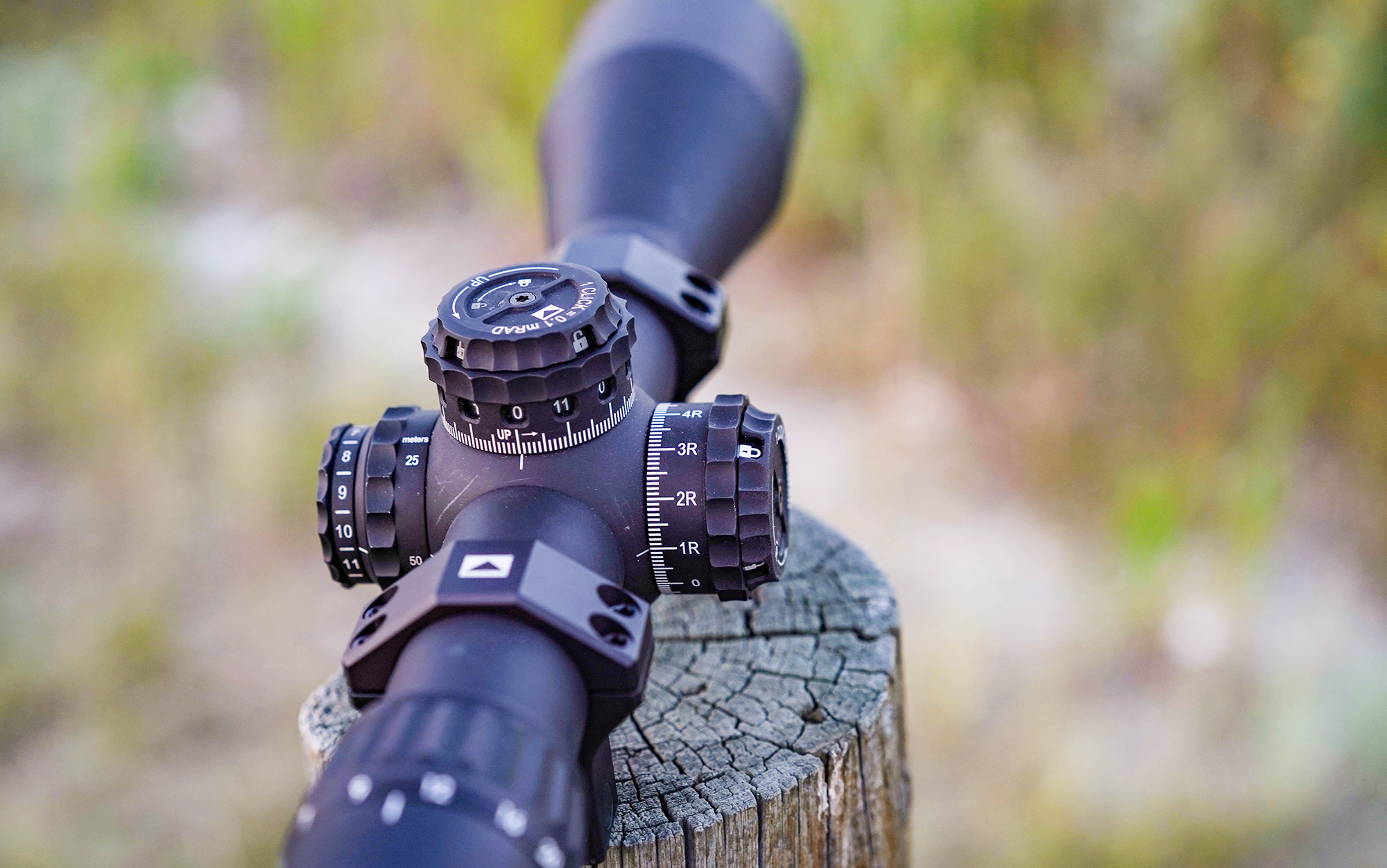
The Steiner’s controls are particularly noteworthy. Both turrets are governed by locking covers. Turn the turret cap to the locked position, and you can’t move the dials with a winch. Turn to unlock, and they move with satisfying precision. The indexing is very good, but Steiner adds a window to the elevation turret that shows single-digit references for the first revolution, but double-digit references for the second revolution. It’s a useful, but slightly gimmicky, device.
Optically, the T6Xi was a standout in the field. It took runner-up status in our low-light test and finished very high in both resolution and image quality considerations. We gave it high points for design and precision, and especially like the insane amount of mounting dimensions on its long 34mm tube. We felt the parallax adjustment could use some loosening. At about $2,600 it’s about a grand cheaper than the most expensive competition scopes, but the team felt like it was still a bit overpriced. Still, if you’re looking for a pure competition scope with some interesting flairs, the Steiner is a very good choice.
Tract Toric UltraHD 4-25×50
Score Card
- Optical Performance: Very Good
- Aiming System: Good
- Design: Fair
- Price/Value: Very Good
Key Features
- Class-leading elevation adjustment range
- Locking exposed turrets
- 34mm tube
- First-plane ELR tree-style reticle
- 10-step red illumination
- 15 yard to infinity parallax adjustment
- Rated for rimfire, air guns, and centerfire rifles
- Ships with sunshade and external zero stop
Pros
- Excellent class of glass
- 47 MRAD total elevation adjustment
- At 13.5 inches, relatively short
- Velvety controls
- Extreme Long Range reticle is extremely versatile
- Extremely simple to rezero
Cons
- Elevation turret is disproportionately tall
- External zero stop is easy to lose
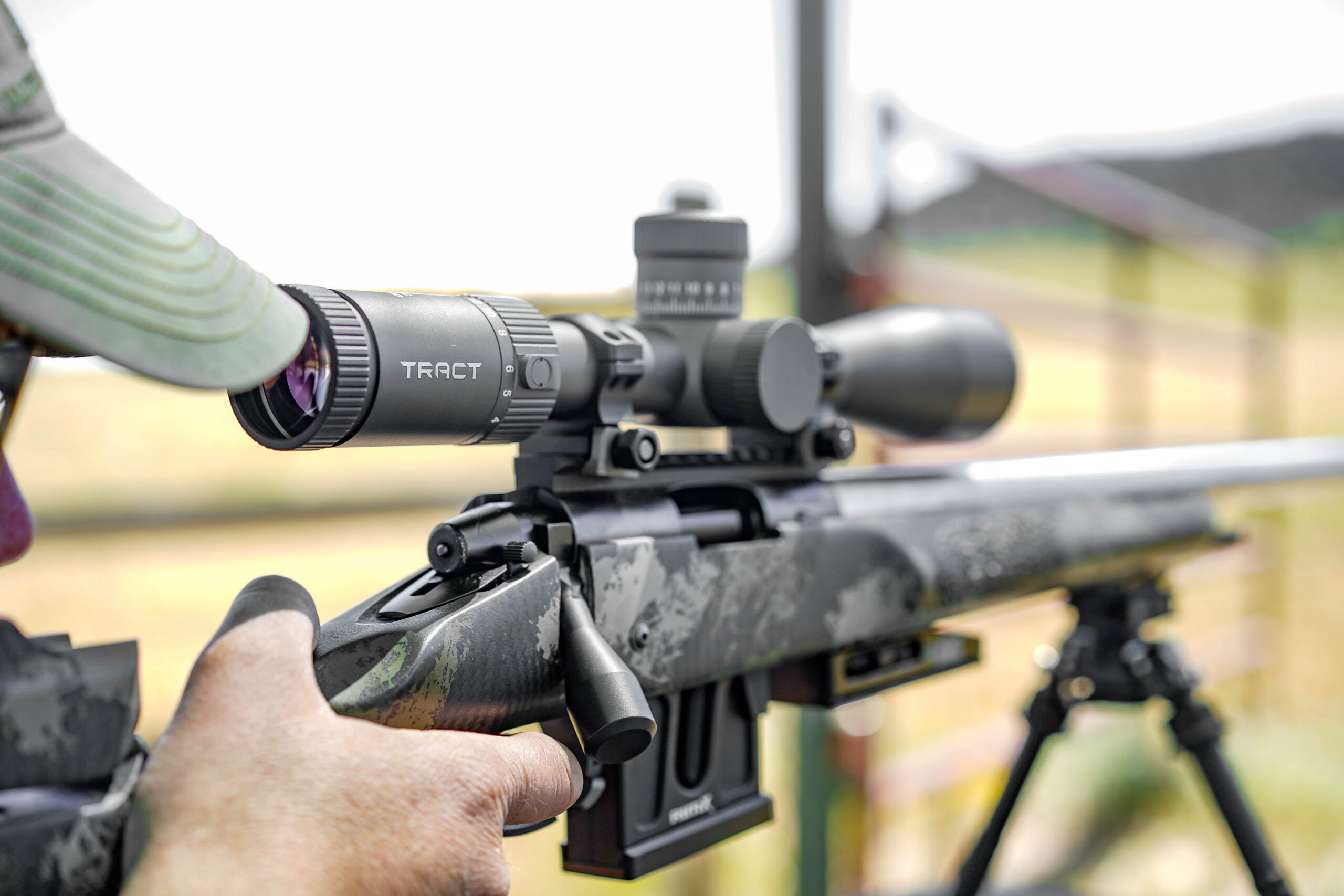
With this butter-smooth, reliable target scope, this direct-to-consumer brand finally has a competition-worthy optic to accompany its excellent hunting scopes. The Toric’s attributes include excellent glass, including high-grade extra-low-dispersion glass in the objective lens and premium high-transmission glass elsewhere. The Tract nearly won the low-light test and garnered high optical-quality scores based on assessments of the image and target clarity.
But it’s the controls that turned testers’ heads. The parallax and illumination knobs both turn with pleasing smoothness, and the pull-to-turn turrets similarly move as though they’re turning on ball-bearing races. As nicely as they turned, though, testers unanimously dinged the Tract for the over-tall elevation turret that is awkward looking and can catch on rifle scabbards and rails and windows of some competition stages. The turret gets even taller when the locking cap is lifted to turn the knob. That unfortunate design is moderated by a great degree by the impressive 47 MILS of internal elevation adjustment. That’s by far the most in our precision-scope class.
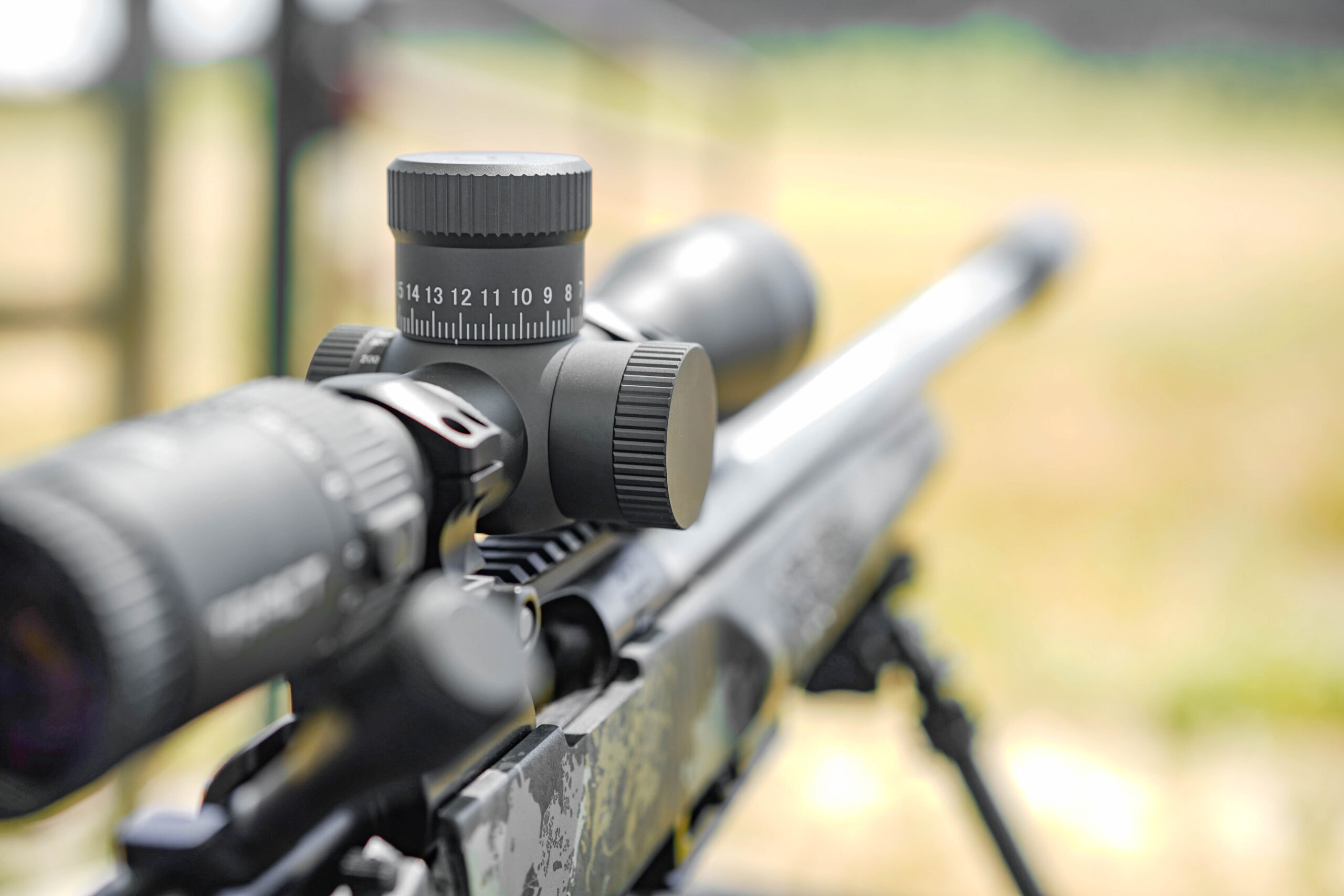
Tract’s ELR (it stands for Extreme Long Range) first-plane reticle is a marvel of simplicity and detail. Built around a .4 MRAD floating center dot with .2 MIL windage and elevation corrections with .5 MIL quick-reference marks, the reticle doesn’t obscure targets but provides fast and certain holds. The reticle is versatile enough to work for long-range steel but also close-range rimfire and air rifle targets.
In all, it’s an impressive entry in a new category for Tract and, at about $1,500, it’s a relative bargain compared with some of its precision-scope peers. Plus, for a shooter who prefers to dial aiming solutions instead of holding over, the Toric’s turret and massive internal adjustment are just your thing.
Best Entry-Level: Arken EPL-4 6-24×50
Score Card
- Optical Performance: Good
- Aiming System: Good
- Design: Fair
- Price/Value: Very Good
Key Features
- 30mm tube
- At 24.7 ounces, very light weight
- 20 MIL elevation, 12 MIL windage adjustment
- First-plane Variable Hunter reticle
- Six-step illumination
- 10 yards to infinity parallax adjustment
- Zero stop
Pros
- Cross-over hunting and target scope
- Extremely accessible price
- Exposed elevation turret, capped windage turret
- Ships with 30mm rings
Cons
- Mushy turret clicks
- Reticle lacks meaningful windage references
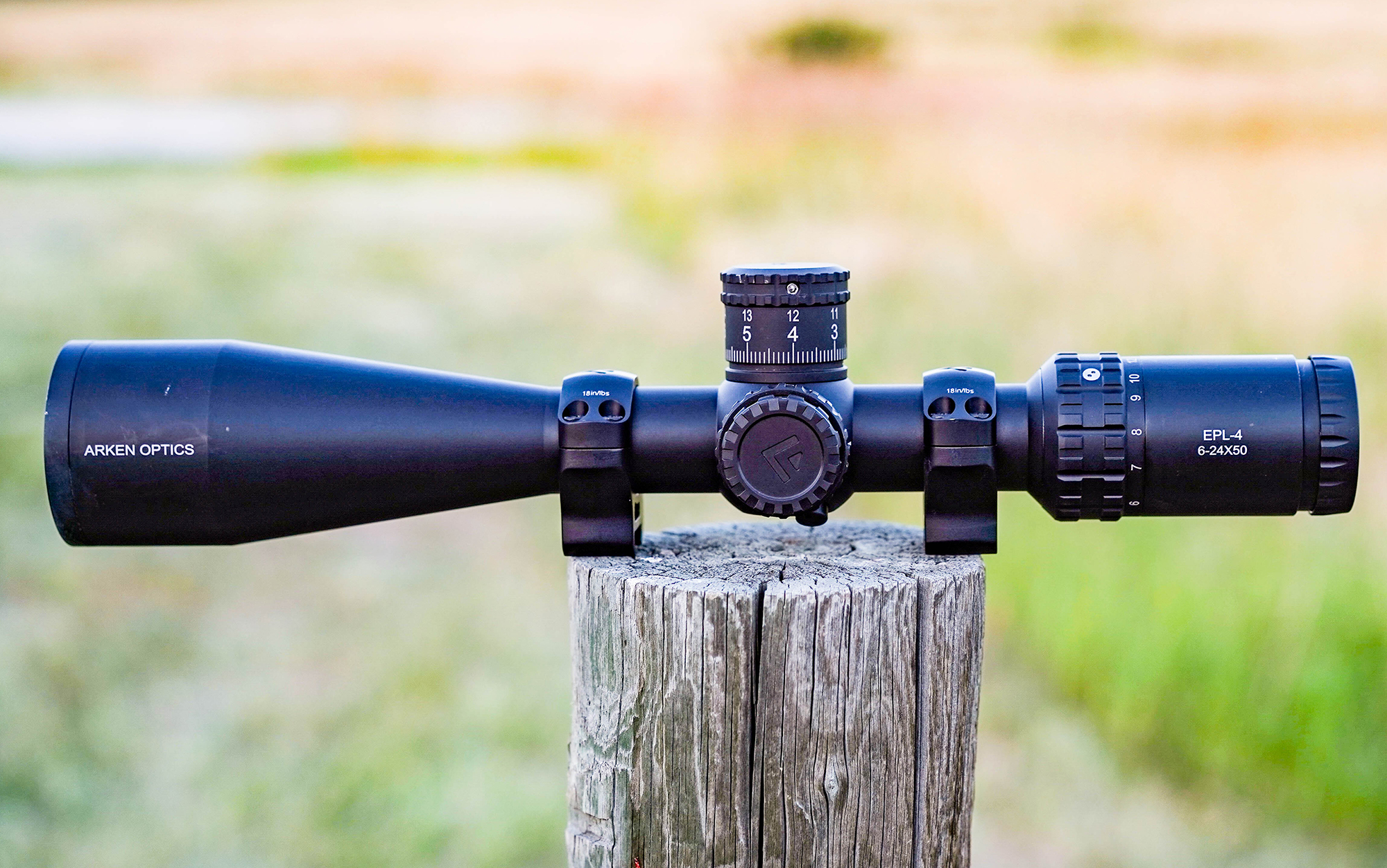
There’s no way to talk about this scope without mentioning the insane price. For well under $500 you get an immensely versatile and responsive scope that can top just about any rifle in your collection. Want a long-range hunting optic? The 30mm scope’s light weight and trim size, along with its excellent MIL-based hash reticle can hold or dial to distant game. Want a versatile target scope that will pick off tiny rimfire targets and reach out to distant steel? The Japanese-made Arken is a good choice.
Of course, there are some good reasons the company is able to bring this scope to market at this extremely accessible price. The glass is very good for the price, but we noted edge distortion, color flaring, and the resolution score was among the lowest in the class. The zero stop doesn’t have a solid wall, but instead has a little bit of mush. The same can be said for the indistinct turret clicks. Probably as a function of its 30mm tube, the internal elevation and windage adjustment range were among the smallest in the field.
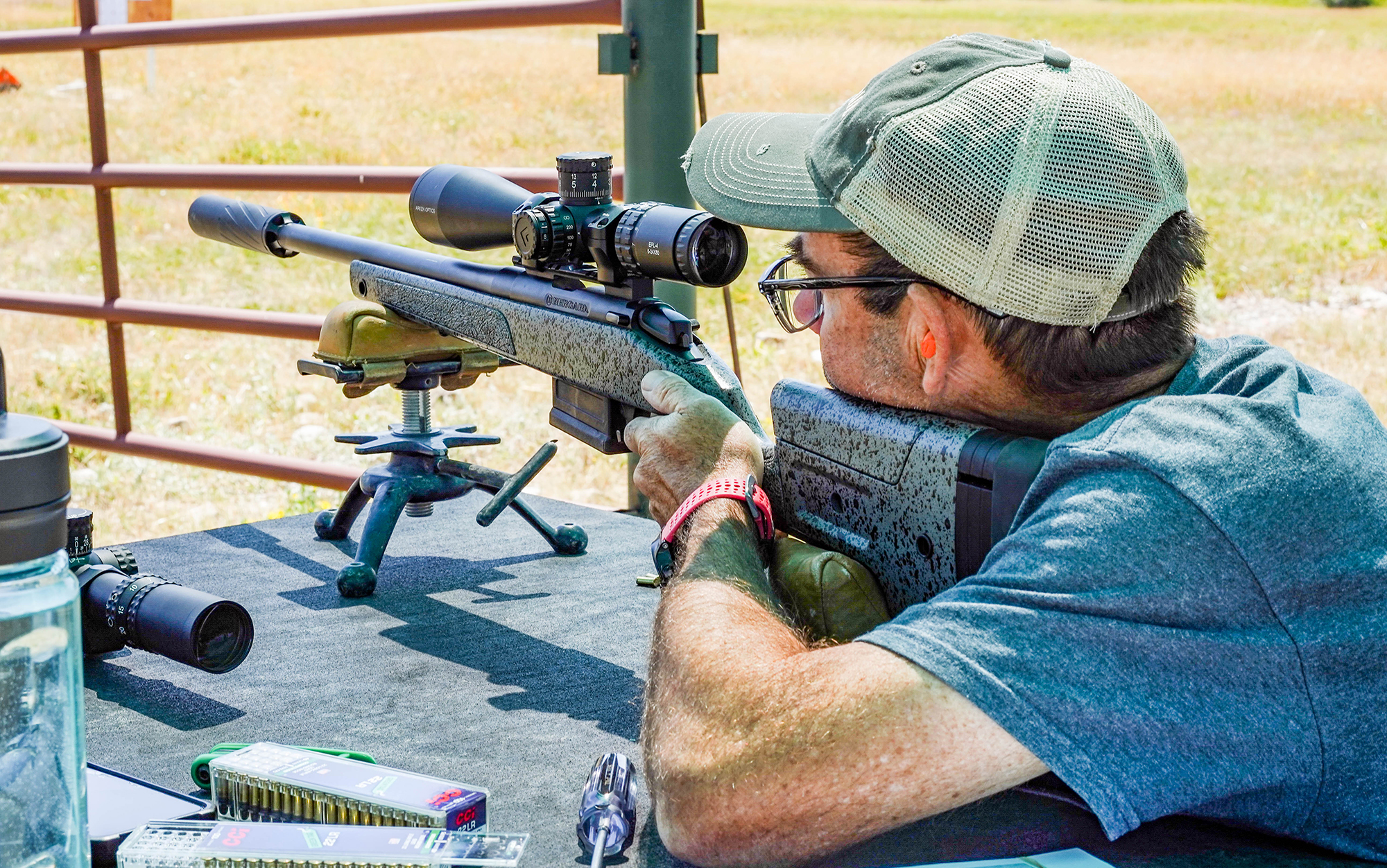
But we had little trouble returning the turrets to their zero, and we liked the obvious and fast turret indexing. The 10-yard close focus makes this a natural choice for a rimfire scope. The red center-cross illumination is nicely rendered. The included scope rings are excellent, and add to the product’s value proposition. In fact, had the Bushnell Match Pro ED not been in our test, the Arken EPL-4 would certainly have won our Great Buy award.
While the Arken lacks some of the pure precision attributes of the Bushnell, the EPL-4 should be considered as a handy scope for any number of shooting situations, at a price that makes it an excellent bargain.
Riton 7 Conquer 4-32×56
Score Card
- Optical Performance: Fair
- Aiming System: Good
- Design: Good
- Price/Value: Poor
Key Features
- Updated design and components
- First-plane PSR MRAD reticle
- 34mm tube
- Six-step red illumination
- 31 MIL elevation, 14.5 MIL windage adjustment
- Pop-up post revolution indicator on elevation turret
- 15 yards to infinity parallax adjustment
- Ships with additional MOA-based turret
Pros
- Multi-position and multi-height throw lever
- All-steel erector system
- Transferable lifetime warranty
- ED glass in objective lens
- Solid and simple zero stop
- Useful, versatile PSR competition reticle
- Useful reticle references
Cons
- Disappointing optics
- Overpriced for overall package and performance
Riton has rightly recognized the insatiable market for competition scopes, and the 7 Conquer has been rushed to shooters looking for different brands and slightly different attributes to stand out in a crowded field. The 7 Conquer is an adequate scope, and some of its features, including a very good zero stop and a useful revolution indicator on the elevation turret, will help shooters ring steel. But overall, we felt that with the rise of the true budget precision scopes—Bushnell’s Match Pro ED and Arken’s EPL-4—the Riton was overpriced for its performance.
The Riton has been redesigned with a better class of glass than the original. The company claims it used extra-low-dispersion glass in its objective lens and a high-definition glass formula in internal lenses. But on the rifle range, resolution range, and low-light range, we found the optical performance underwhelming.
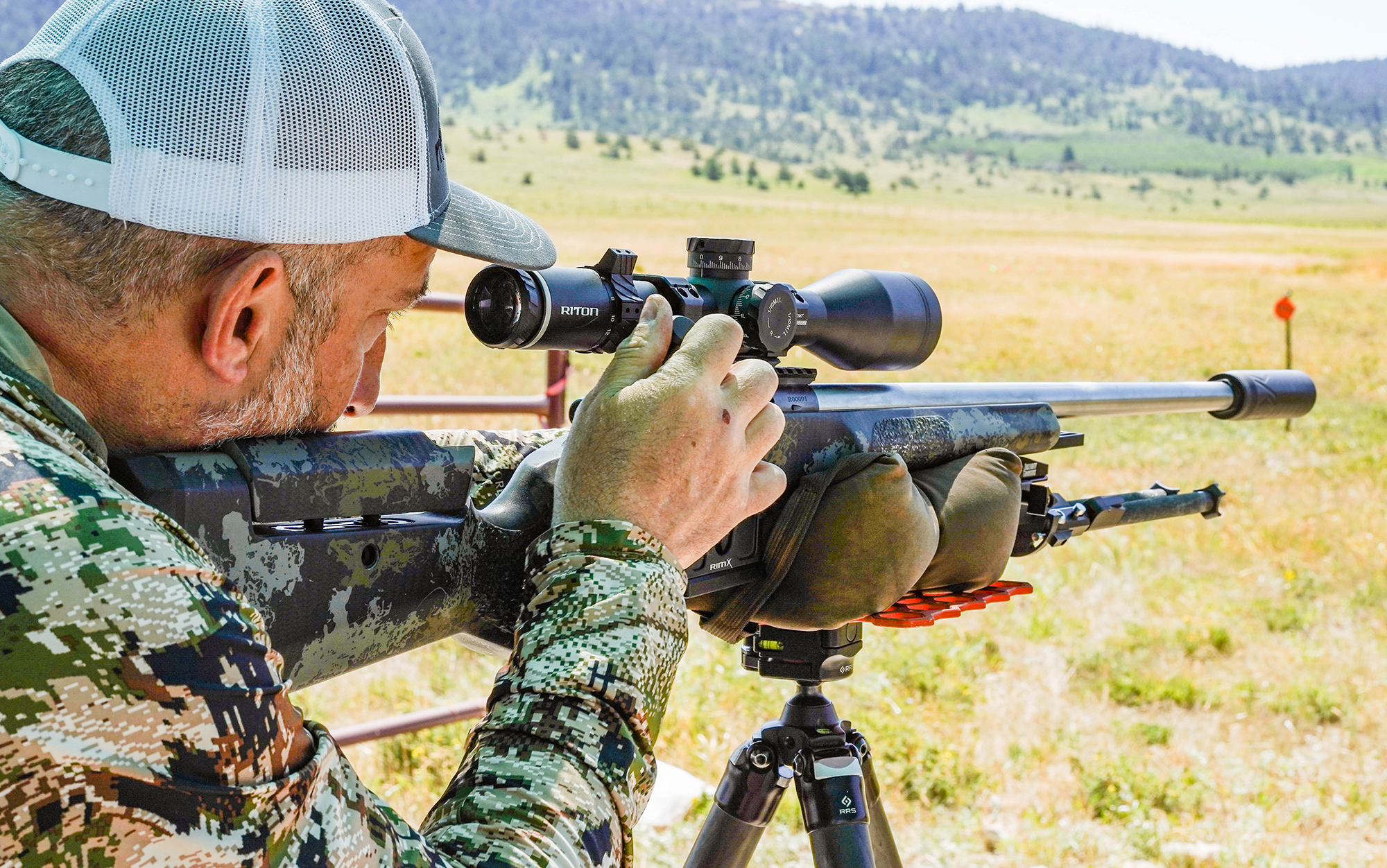
The controls and reticle, on the other hand, exceeded our expectations. The PSR reticle is built around a .04 MRAD center dot with .2 MRA elevation references and 12 MRAD of total elevation references. It’s a decently fast and clear architecture, and given the scope’s 15-yard close focus, should make it a good rimfire as well as centerfire competition scope. The steel-on-steel zero stop makes a formidable back wall, but most testers reported that turret movement felt cheap. Testers also questioned the inclusion of an MOA turret for a reticle built around MRAD references. “I’d rather they shipped a blank turret so that I could dial custom solutions,” said one tester, citing the blank “race dial” that ships with the Burris XTR Pro.
The 7 Conquer also lost design points from testers who felt the build is derivative and doesn’t really offer much to shooters that they can’t get from other brands. Still, the Riton has produced a capable scope that will get shooters into competitions, though we think they’d have broader appeal by dropping the price.
How to Choose A Precision Rifle Scope
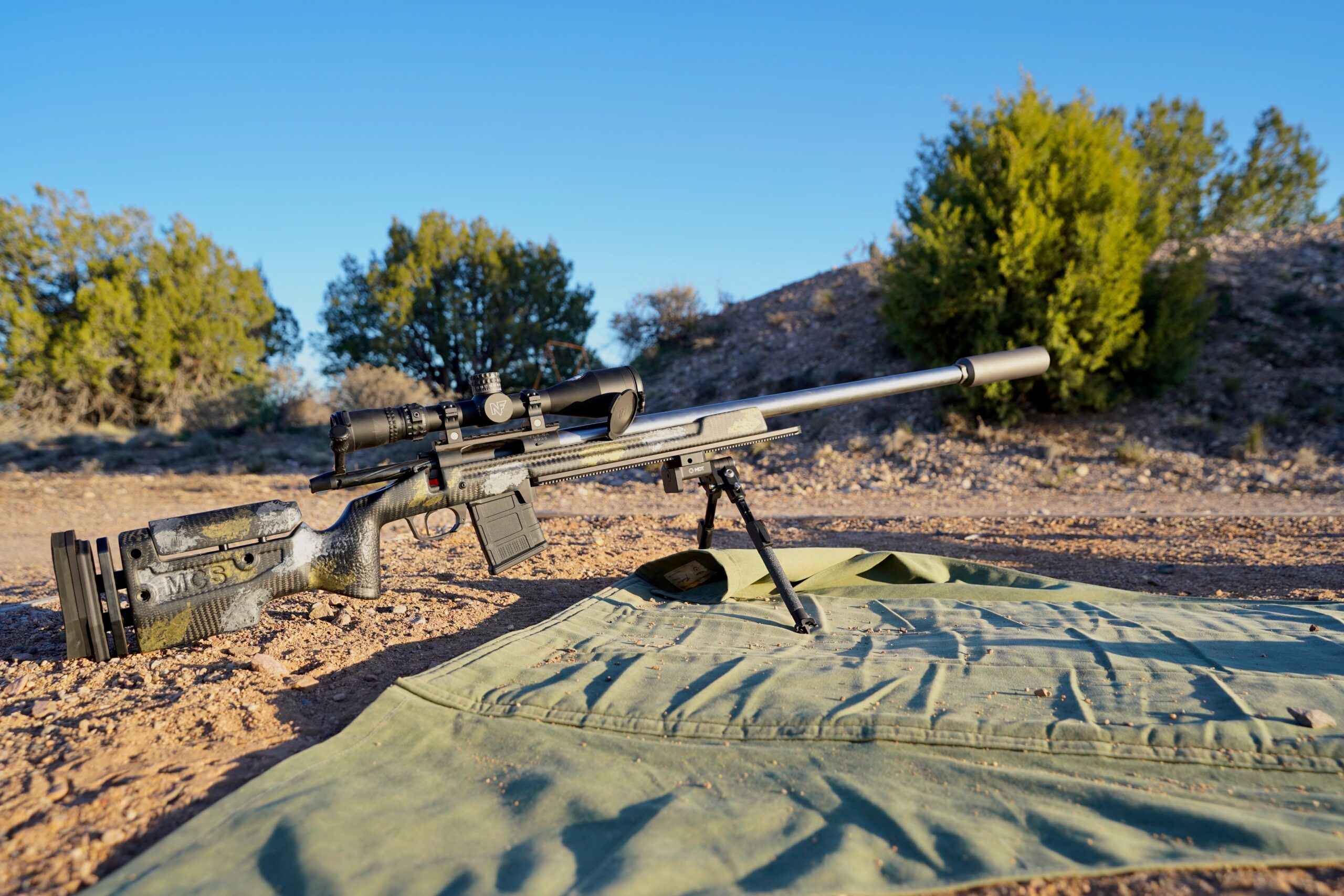
A few years ago a precision scope was one that had exposed turrets and a reticle with enough references to hold over and off for distant targets. That’s no longer the case, as this class of optics has narrowed its capabilities to a few very precise and necessary attributes. It must have a first-plane reticle with abundant references for fine adjustments of windage and elevation. It must have turrets tuned to the reticle geometry, with tactile feedback that allow shooters to count clicks as they dial aiming solutions.And it must have a magnification range that enables engagement with tiny targets inside 50 yards and targets out to a mile or more. Most magnification ranges zoom from 5 to about 25 or 30 power.
Competition shooters are increasingly converting to MIL-based scopes, largely because the MRAD system offers a simpler, cleaner, and more intuitive aiming system than the cluttered MOA system. Submissions to this year’s test indicate that transition is nearly complete; only one precision scope offers an MOA-based reticle.
The category has expanded in recent years with the rise of rimfire precision competitions in which shooters engage wee targets at ranges from 10 to 300 yards. Scopes that have parallax adjustments that come as close as 15 yards are useful for these new games. Add optional reticle illumination and at least 20 MIL (68 MOA) of internal elevation adjustment, so that shooters can dial aiming solutions from their zero out to 1,000 yards or more without using reticle hold-over.
These days, the best long range rifle scopes needs to have all those attributes. Of course, all that precision gearing and glass costs money, which is why most serious competition scopes retail for $2,000 or more. But we are thrilled to see the industry respond, and offer excellent scopes this year for under $600.
Final Thoughts on the Best Long Range Rifle Scopes
Yes, the best long range rifle scope is defined by specialized attributes, as we noted above. But it’s also constrained by brand allegiance and blind conformity. That’s not unusual in any competitive endeavor, from race cars to running. Competitors go with—and stick with—the gear that works. But for optics brands trying to break into the precision riflescope ranks, or to offer an innovation, that conformity can turn to resistance.
That’s one reason we’re so excited to see some real innovation in this year’s submissions. Vortex’s new clickless zero system and Burris’s tool-less turret are both welcome additions that not only solve a problem but advance the state of this very specialized platform. We’re equally excited to see affordability rise as an attribute, and allow more people to become better, more capable competitors not only on long-range steel ranges, but in any shooting situation they choose.
- Best Overall: Leica PRS 5-30x56i
- Best Value: Bushnell Match Pro ED
- Best Innovative Riflescope: Vortex Razor HD Gen III 6-36×56
- Best MOA-Based Precision Scope: Nightforce ATACR 7-35×56 F1
- Best Competition Scope: Burris XTR Pro 5.5-30×56
- Steiner T6Xi 5-30×56
- Tract Toric UltraHD 4-25×50
- Best Entry-Level: Arken EPL-4 6-24×50
- Riton 7 Conquer 4-32×56
